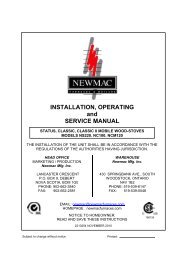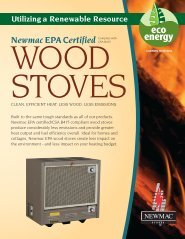INSTALLATION, OPERATING and SERVICE MANUAL - Newmac ...
INSTALLATION, OPERATING and SERVICE MANUAL - Newmac ...
INSTALLATION, OPERATING and SERVICE MANUAL - Newmac ...
You also want an ePaper? Increase the reach of your titles
YUMPU automatically turns print PDFs into web optimized ePapers that Google loves.
insulated, pre-fabricated metal chimney has the least serious creosote problems; its insulation helps<br />
maintain higher temperatures on its inner surface, <strong>and</strong> its low heat capacity allows it to warm up very<br />
quickly after a fire is started. Masonry chimneys frequently accumulate deposits at the beginnings of fires<br />
<strong>and</strong> their interior surfaces take a longer time to warm because the construction is so massive. Any type<br />
of chimney which runs up the outside of a house is more susceptible to creosote problems than the same<br />
type of chimney rising in the houses’ interior, due to the cooling effect of the colder outdoor air on the<br />
exterior chimney.<br />
Average flue gas temperatures can be increased by minimizing the length of stove pipe connecting the<br />
stoves to the chimney. This, of course, will also decrease the energy efficiency of the system, <strong>and</strong> its<br />
often true that measures which decrease creosote formation also decrease heating efficiency. For<br />
instance, stoves which have energy efficiencies due to their relatively good heat transfer (e.g. the Sevca,<br />
lange 6303 <strong>and</strong> double barrel stoves) are more likely to have chimney creosote problems precisely<br />
because they do such a good job extracting heat from the flue gases.<br />
Generally creosote is inevitable <strong>and</strong> must be lived with. Any kind of chimney deposit decreases the<br />
system’s heating efficiency. Soot <strong>and</strong> dried creosote accumulations have a significant insulating effect;<br />
less of the heat in the flue gases is transferred into a house through dirty stovepipe <strong>and</strong> chimneys.<br />
The most annoying problem can be creosote dripping from a stovepipe or chimney, <strong>and</strong> the most<br />
dangerous problem is chimney fires, during which the creosote, or its pyrolyzed residue, burns.<br />
Creosote dripping can usually be eliminated. Joints in vertical segments of stovepipe will not leak if, at<br />
the joints, the smaller, crimped ends always stick down into the receiving end. (Smoke will not leak out of<br />
the joints due to this direction of overlap.) Since this is not the usual orientation for stovepipe, a double<br />
male fitting may be necessary at some point to connect the stovepipe to the stove, a prefabricated<br />
chimney, or a rain cap. Special drip-proof adapters are available for connecting some sizes of stovepipe<br />
to Metalbestos br<strong>and</strong> pre-fabricated chimneys. Common types of stove pipe elbows can leak creosote<br />
due to their swivel joints; rigid <strong>and</strong> accordion-type leakproof elbows are available. Horizontal or gently<br />
sloping sections of stove pipe should be oriented so their seams are on top. Joints between horizontal<br />
pipes <strong>and</strong>/or fittings are the most difficult to seal against dripping. A good high-temperature sealant can<br />
sometimes help, but is not guarantee. The joint must also be snug, <strong>and</strong> well secured with sheet-metal<br />
screws. If all joints are made leak-proof, then the creosote will generally drip into the stove, where, when<br />
the fire is hot, it will be burned.<br />
Chimney fires occur when the combustible deposits on the inside of a chimney burn. The deposits may<br />
be ‘raw’ creosote, pyrolyzed creosote, or soot. Ignition requires adequate oxygen, which is usually<br />
available, <strong>and</strong> sufficiently high temperatures the same conditions are for the ignition <strong>and</strong> combustion of<br />
any fuel. Chimney fires are most likely to occur during a very hot fire, as when cardboard or Christmas<br />
tree branches are burned, or even when a stove burns normal wood, but at a higher than normal rate. A<br />
crackling sound can often be heard at the beginning of a chimney fire. As the intensity of the fire rises,<br />
the stove pipe will sometimes shake violently, air will be very forcefully drawn in through the stove, <strong>and</strong><br />
the stove pipe may glow red hot. A tall plume of flame <strong>and</strong> sparks can be seen rising from the top of<br />
uncapped chimneys.<br />
The most effective way to suppress a chimney fire is to limit its air supply although both water <strong>and</strong> salt are<br />
sometimes suggested. If a relatively air-tight stove is the connected appliance, this is easily done by closing<br />
the stove’s air-inlet dampers, if all the stove pipe <strong>and</strong>/or chimney joints are tight, <strong>and</strong> if no other appliance is<br />
connected to the same flue.<br />
In a properly designed <strong>and</strong> maintained chimney, the only potential hazard related to chimney fires is ignition of<br />
the building’s roof or surroundings due to sparks <strong>and</strong> burning embers coming out of the top of the chimney. A<br />
spark arresting screen can decrease, but not eliminate this possibility, but spark screens themselves are often<br />
not suitable for use with wood fuel because they can become clogged. The chimney itself <strong>and</strong> the stove pipe, when<br />
properly installed, are intended to withst<strong>and</strong> an occasional chimney fire without danger of ignition of their<br />
surroundings. During a chimney fire check the roof <strong>and</strong> surroundings <strong>and</strong> possibly wet down critical areas. If the<br />
chimney may not be up to safety st<strong>and</strong>ards, one should also keep a close watch on all surfaces near the chimney.<br />
Some people start chimney fires fairly frequently, as a means of chimney cleaning. This deters very intense chimney<br />
fires <strong>and</strong> the small ones which do happen are always under a watchfull eye. Under some circumstances, this<br />
practice may be reasonable, but generally it is a risky method to keep a chimney clean. There is always some<br />
danger of a house fire, but in addition, any chimney fire is wearing on a chimney; the high temperatures increase the<br />
corrosion rate of metals <strong>and</strong> the thermal expansion of masonry materials encourage crack formation <strong>and</strong> growth.<br />
11




